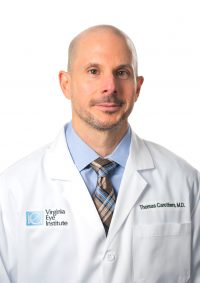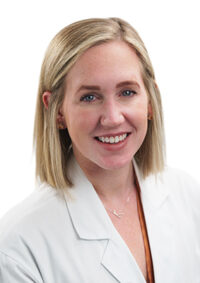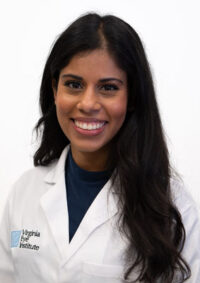Good vision develops early in life. A newborn’s vision develops rapidly during the first year. Therefore, early detection of childhood eye diseases and problems is critical so that the risk of permanent visual impairment is minimized. When we help diagnose any eye diseases for a child, we make it a priority to see their siblings due to the hereditary nature of eye diseases.
Eye Exams For Children
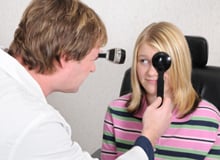
What to Look For
If your baby can’t make steady eye contact by 2-3 months of age, or seems unable to see, you should consult your pediatrician and ask for a referral to the pediatric ophthalmologists at Virginia Eye Institute. A constant crossing or out-turning of the eyes (sometimes called a “lazy” eye) is usually abnormal; though most babies do occasionally cross their eyes during their first 3 months of life. Babies older than 3 months of age can usually follow or “track” an object with their eyes as it moves from place to place.
- Normal Vision Development in Babies, Toddlers, Preschoolers, and School-Aged Children
- Focus and Alignment Disorders that Affect Children’s Vision
- Common Childhood Eye Diseases
- Preventing and Treating Eye Injuries
- Proper Age Intervals for Eye Exams
- Learning Disabilities and Vision
- For more information, visit American Association for Pediatric Ophthalmology and Strabismus, American Association of Certified Orthoptists, and American Academy of Pediatrics
Normal Vision Development in Children
There are many eye conditions and diseases that can affect a child’s vision. Some of the more common focus and alignment disorders and eye diseases are listed below. Early diagnosis and treatment are critical to maintaining your child’s eye health. If any of the following conditions is suspected, the child will need to be examined by a pediatric ophthalmologist.
Amblyopia (Lazy Eye)
What it is
Amblyopia is a term used to mean poor vision in an eye that has not developed normal sight (usually during early childhood). The condition is sometimes called “lazy eye.” It occurs when visual acuity is much better in one eye than the other. Amblyopia is common and affects two or three of every 100 people in the U.S.
What to look for
Amblyopia can be a result of strabismus (misaligned eyes). One eye may look straight ahead while the other turns in, out, up or down. The eye turn may be constant or may be occasional or intermittent. Signals from the misaligned eye are “turned off” by the brain to avoid double vision, so the child uses only the better-seeing eye. Strabismus affects about 4 percent of children in the U.S. Amblyopia can result from eye problems other than strabismus as well.
What to do
If it seems that the vision in one of the child’s eyes is significantly better (or weaker) than the other, the child needs to be examined by an Eye M.D. (ophthalmologist).
Cataract (Cloudy Eyes)
If the surface of the eye, which is normally clear, instead appears cloudy, the child may have a cataract or childhood eye disorder that needs treatment.
Ptosis (Droopy Eyelids)
Ptosis involves a drooping upper eyelid that covers the eye either somewhat or entirely, and so blocks vision.
Common Childhood Eye Diseases
When the following diseases are suspected, the child needs to be examined by a primary care physician or children’s health service, who will co-manage the child’s care with an ophthalmologist when necessary.
Conjunctivitis (pink eye)
Conjunctivitis can refer to either a viral or bacterial infection (both very contagious), or an allergic reaction (not contagious).
What to look for
The eye appears red or pink due to inflammation of the conjunctiva, the thin, filmy membrane that covers the inside of eyelids and white part of eye.
The eye tears and/or has discharge, and is usually itchy and uncomfortable.
When a viral infection is the cause, the child may also have a fever, sore throat and runny nose.
What to do
If the child has (or may have) contagious pink eye, he or she needs to stay home from school or return home to avoid infecting others. Contagious pink eye usually resolves in three to seven days. When the tearing and discharge from the eyes has stopped the child may return to school.
Chalazion
Chalazion looks like a small lump on the eyelid, and may occur when a meibomian gland (an oil-secreting gland in the eyelid) becomes clogged. It is not caused by infection.
Stye
A stye looks like a red, sore lump near the edge of the eyelid; it is caused by an infected eyelash follicle.
Preceptal or Orbital Cellulitis
Cellulitis is an infection related to trauma, an upper respiratory infection or an eyelid infection.
What to look for
- The tissues around the eye appear red and painfully swollen. The condition usually occurs in one eye, which may be swollen shut.
- The child may have a fever.
- More serious preceptal or orbital cellulitis infections can cause decreased vision, an inability to move the eye, and the appearance of the eye being pushed forward.
What to do
- Both forms of cellulitis are serious conditions that require urgent medical attention. Take the child to a primary care doctor or other qualified health professional who will co-manage the child’s treatment with an ophthalmologist.
- When children participate in sports, recreation, crafts or home projects, it’s important for them to know eye safety practices and use protective glasses as appropriate. Each year thousands of children sustain eye damage or even blindness from accidents at home, at play or in the car. More than 90 percent of all eye injuries can be prevented through use of suitable protective eyewear.
- Sports deserve particular attention, because eye injuries occur fairly often in children and young adult athletes: between the ages of five and 14, most sports-related injuries in the U.S. occur while playing baseball. Virginia Eye Institute optical shops offer a full range of rec-specs.
Preventing & Treating Child Eye Injuries
Children should wear sports eye protectors made with polycarbonate lenses for baseball, basketball, football, racquet sports, soccer, hockey, lacrosse, and paintball.
- All chemicals and sprays must be kept out of reach of small children.
- Parents and others who provide care and supervision for children need to practice safe use of common items that can cause serious eye injury, such as paper clips, pencils, scissors, bungee cords, wire coat hangers and rubber bands.
- Model eye health by safeguarding your own sight with ANSI-approved protective eyewear during potentially dangerous yard work and household repairs or projects.
- Only purchase age-appropriate toys.
- Avoid projectile toys such as darts, bows and arrows, and missile-firing toys.
- Look for toys marked with “ASTM”, which means the product meets the national safety standards set by the American Society for Testing and Materials.
- Use safety gates at the top and bottom of stairs. Pad or cushion sharp corners. Put locks on all cabinets and drawers that kids can reach.
- Do not allow your children to play with non-powder rifles, pellet guns or BB guns. They are extremely dangerous and have been reclassified as firearms and removed from toy departments.
- Do not allow children anywhere near fireworks, especially bottle rockets. These fireworks pose a serious risk of eye injury and have been banned in several states.
- When very small children (age 4 and younger) are bitten by dogs, eye injuries occur about 15 percent of the time. The dog is usually one the child is familiar with, and second attacks by the same dog are likely to cause more serious injury. It is recommended that any dog that bites a child be removed from the household.
- On the road, make sure children are properly secured in baby carriers and child safety seats and that the seat and shoulder belts fit well. Children age 12 and younger should never ride in the front seat. Store loose items in the trunk or secured on the floor, as any loose object can become a dangerous projectile in a crash.
First Aid
An ophthalmologist, primary care doctor, school nurse or children’s health service should examine the eye as soon as possible, even if the injury seems minor at first, as a serious injury is not always immediately obvious. Delaying medical attention can cause the damaged areas to worsen and could result in permanent vision loss or blindness.
While seeking medical help, care for the child as follows:
- DO NOT touch, rub or apply pressure to the eye.
- DO NOT try to remove any object stuck in the eye. For small debris, lift eye lid and ask child to blink rapidly to see if tears will flush out the particle. If not, close the eye and seek treatment.
- Do not apply ointment or medication to the eye.
- A cut or puncture wound should be gently covered.
- Only in the event of chemical exposure, flush with plenty of water.
Vision Screen for Children
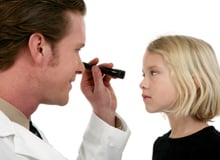
When and how should screening be done?
It is essential to check children’s vision when they are first born and again during infancy, preschool and school years. The American Academy of Ophthalmology and the American Association for Pediatric Ophthalmology and Strabismus recommend the following exams:
Newborn
An ophthalmologist, pediatrician, family doctor or other trained health professional should examine a newborn baby’s eyes and perform a red reflex test (a basic indicator that the eyes are normal). An ophthalmologist should perform a comprehensive exam if the baby is premature or at high risk for medical problems for other reasons, has signs of abnormalities, or has a family history of serious vision disorders in childhood.
Infant
A second screening for eye health should be done by an ophthalmologist, pediatrician, family doctor or other trained health professional at a well-child exam between six months and the first birthday.
Preschooler
Between the ages of 3 and 3½, a child’s vision and eye alignment should be assessed by a pediatrician, family doctor, optometrist, orthoptist or person trained in vision assessment of preschool children.
Visual acuity should be tested as soon as the child is old enough to cooperate with an eye exam using an eye chart. Photoscreening is another way to check visual acuity that does not require a young child to cooperate with the test. Either approach to testing will determine whether the child can focus normally at far, middle and near distances. Many children are somewhat farsighted (hyperopic) but can also see clearly at other distances. Most children will not require glasses or other vision correction.
If misaligned eyes (strabismus), “lazy eye” (amblyopia), refractive errors (myopia, hyperopia, astigmatism) or another focusing problem is suspected in the initial screening, the child should have a comprehensive exam by an ophthalmologist or pediatric ophthalmologist. It’s important to begin treatment as soon as possible to ensure successful vision correction and life-long benefits.
School Age
Upon entering school, or whenever a problem is suspected, children’s eyes should be screened for visual acuity and alignment by a pediatrician, family doctor, optometrist, orthoptist, or person trained in vision assessment of school-aged children, such as a school nurse. Nearsightedness (myopia) is the most common refractive error in this age group and can be corrected with eyeglasses. If an alignment problem or other eye health issues is suspected, the child should have a comprehensive exam by an ophthalmologist.
Learning Disabilities and Children’s Vision
Learning disabilities include disorders in understanding or using spoken or written language or symbols. These disorders result from the brain’s misinterpretation of images received and relayed by the eyes, rather than from structural or functional problem in the eyes. That’s why learning disabilities are not treatable by eye exercises or vision therapy. Children with learning disabilities do not have more visual problems than those who do not have learning disabilities.
What to look for
The child may experience problems with reading (dyslexia), writing, listening, speaking, concentration, or mathematical calculations.
What to do
Public schools are required by law to evaluate any child who is thought to have a learning disability; the evaluation should include a complete eye examination by an ophthalmologist. Treatment for learning disabilities is best provided through an educational approach, using tutors and resource teachers. Whether or not learning disabilities are suspected, all students need vision screening to check for visual acuity and general eye health.


